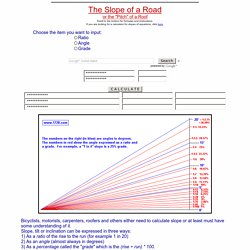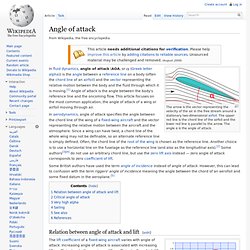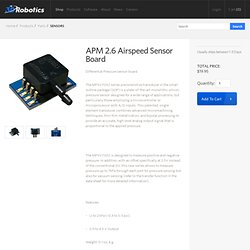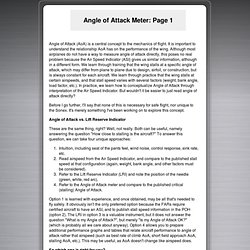

Gradient, Slope, Grade, Pitch, Rise Over Run Ratio Calculator. Bicyclists, motorists, carpenters, roofers and others either need to calculate slope or at least must have some understanding of it.

Slope, tilt or inclination can be expressed in three ways: 1) As a ratio of the rise to the run (for example 1 in 20) 2) As an angle (almost always in degrees) 3) As a percentage called the "grade" which is the (rise ÷ run) * 100. Of these 3 ways, slope is expressed as a ratio or a grade much more often than an actual angle and here's the reason why. Stating a ratio such as 1 in 20 tells you immediately that for every 20 horizontal units traveled, your altitude increases 1 unit. Stating this as a percentage, whatever horizontal distance you travel, your altitude increases by 5% of that distance. Stating this as an angle of 2.8624 degrees doesn't give you much of an idea how the rise compares to the run. Calculating Grade By Measuring The Road Distance run = Square Root (15,844.95² - 396²) run = 15,840 feet Calculating Grade By Using Slope Distance.
Angle of attack. The arrow is the vector representing the velocity of the air in the free stream around a stationary two-dimensional airfoil.

Physics in a Minute: How wings really create lift. Airspeed indicator. FM 3-04.203 Table Of Contents. More theories of lift. Airfoils and Airflow [Ch. 3 of See How It Flies] — Have you heard how to make a small fortune in the aviation business?
![Airfoils and Airflow [Ch. 3 of See How It Flies]](http://cdn.pearltrees.com/s/pic/th/3-airfoils-and-airflow-39027594)
— Start with a large one. 3.1 The Airplane and the Air. Breakout Board MPXV7002DP - 3DRobotics Inc. Differential Pressure Sensor board.

The MPXV7002 series piezoresistive transducer in the small outline package (SOP) is a state-of-the-art monolithic silicon pressure sensor designed for a wide range of applications, but particularly those employing a microcontroller or microprocessor with A/D inputs. This patented, single element transducer combines advanced micromachining techniques, thin-film metallization, and bipolar processing to provide an accurate, high level analog output signal that is proportional to the applied pressure. The MPXV7002 is designed to measure positive and negative pressure. In addition, with an offset specifically at 2.5V instead of the conventional 0V, this new series allows to measure pressure up to 7kPa through each port for pressure sensing but also for vacuum sensing (refer to the transfer function in the data sheet for more detailed information).
Features: - -2 to 2 kPa (-0.3 to 0.3 psi). - 0.5 to 4.5 V Output Weight: 0.1 oz; 4 g. AlphaTrainer. Atstallsyt.m4v. See How It Flies. Aerodynamics and Theory of Flight, Forces of Flight, Lift, Weight, Thrust, Drag, Generating Lift, Airfloils, Angle of Attack, Parasitic Drag, Induced Drag, Groiund Effect, Boundary Layer, Stalls, Factors Affecting Aircraft Stalls, Spins, Aircraft Lift and. Home / Students / Resources / Classroom / Commercial Pilot Groundschool / Aerodynamics and Theory of Flight Forces of Flight Lift Lift is an artificial force manipulated by pilot; it is generated through the wings, acts perpendicular to the relative wind and wingspan.

Airfoils and Airflow [Ch. 3 of See How It Flies] — Have you heard how to make a small fortune in the aviation business?
![Airfoils and Airflow [Ch. 3 of See How It Flies]](http://cdn.pearltrees.com/s/pic/th/3-airfoils-and-airflow-61576504)
— Start with a large one. 3.1 The Airplane and the Air In ordinary steady flight, the airplane must develop enough upward force to support its weight, i.e. to counteract the downward force of gravity. It is a defining property of an aircraft (as opposed to a ballistic missile, spacecraft, or watercraft) that virtually all of this upward force comes from the air. In any case, there is one thing we know for sure:
Angle of Attack Indicator. What is the Angle of Attack?

No, it is not the direction from which you strike your opponent! It is defined as the angle between the chord line of the wing and the direction of the relative wind. What good is it? www.sonex604.com/misc/SA_AOA.pdf. Jeff Shultz's Sonex #0604 Web Site: Angle of Attack Meter - Page 1. Angle of Attack (AoA) is a central concept to the mechanics of flight.

It is important to understand the relationship AoA has on the performance of the wing. Although most airplanes do not have a way to measure angle of attack directly, this poses no real problem because the Air Speed Indicator (ASI) gives us similar information, although in a different form. We learn through training that the wing stalls at a specific angle of attack, which may differ from plane to plane due to design, airfoil, or construction, but is always constant for each aircraft. We learn through practice that the wing stalls at certain airspeeds, and that stall speed varies with several factors (weight, bank angle, load factor, etc.).
www.sonex604.com/misc/AirsoobLRI.pdf. Angle of Attack Awareness and Angle of Attack Management [Ch. 2 of See How It Flies] If you want to go up, pull back on the yoke.
![Angle of Attack Awareness and Angle of Attack Management [Ch. 2 of See How It Flies]](http://cdn.pearltrees.com/s/pic/th/attack-awareness-management-63878658)
If you want to go down, pull back a little more. If you want to go down real fast and spin around and around and around, just keep pulling back.